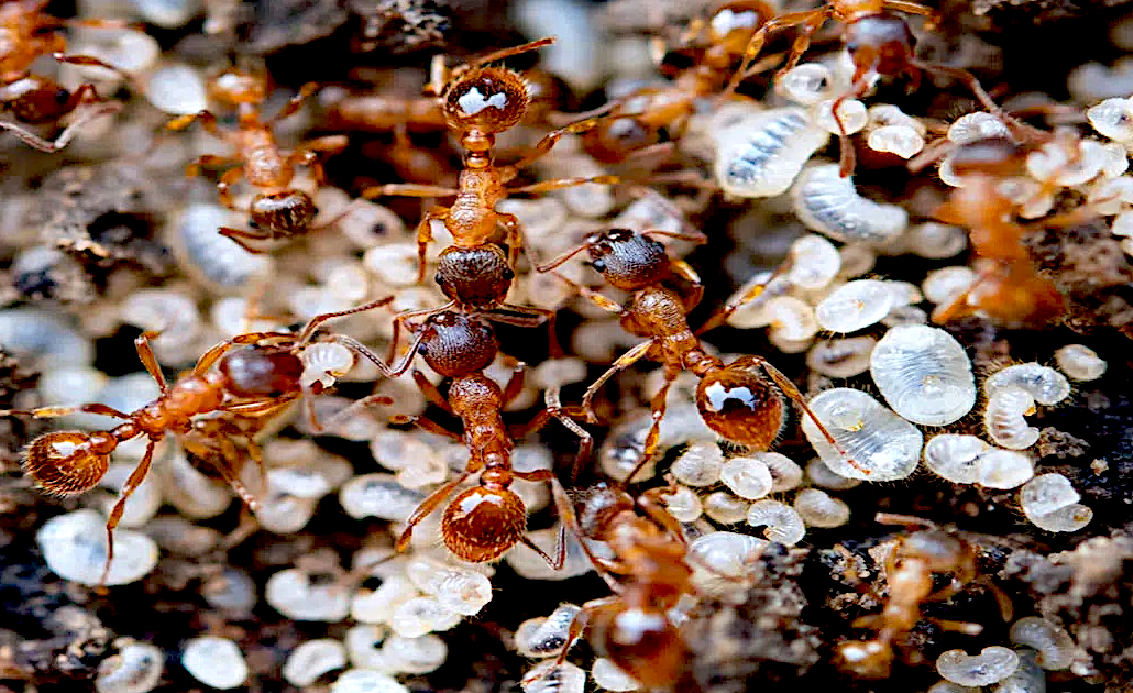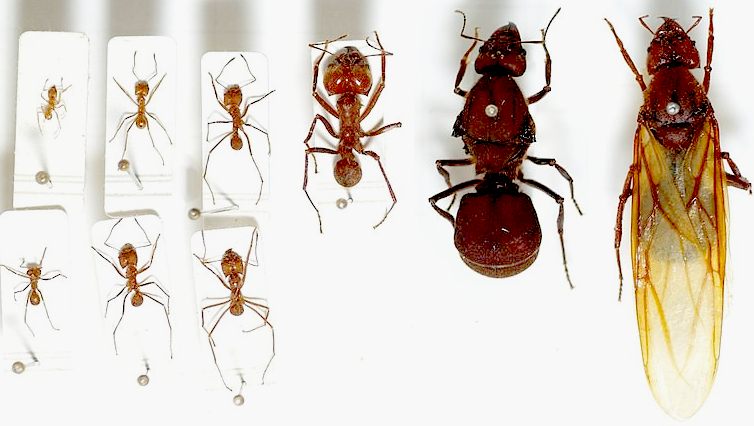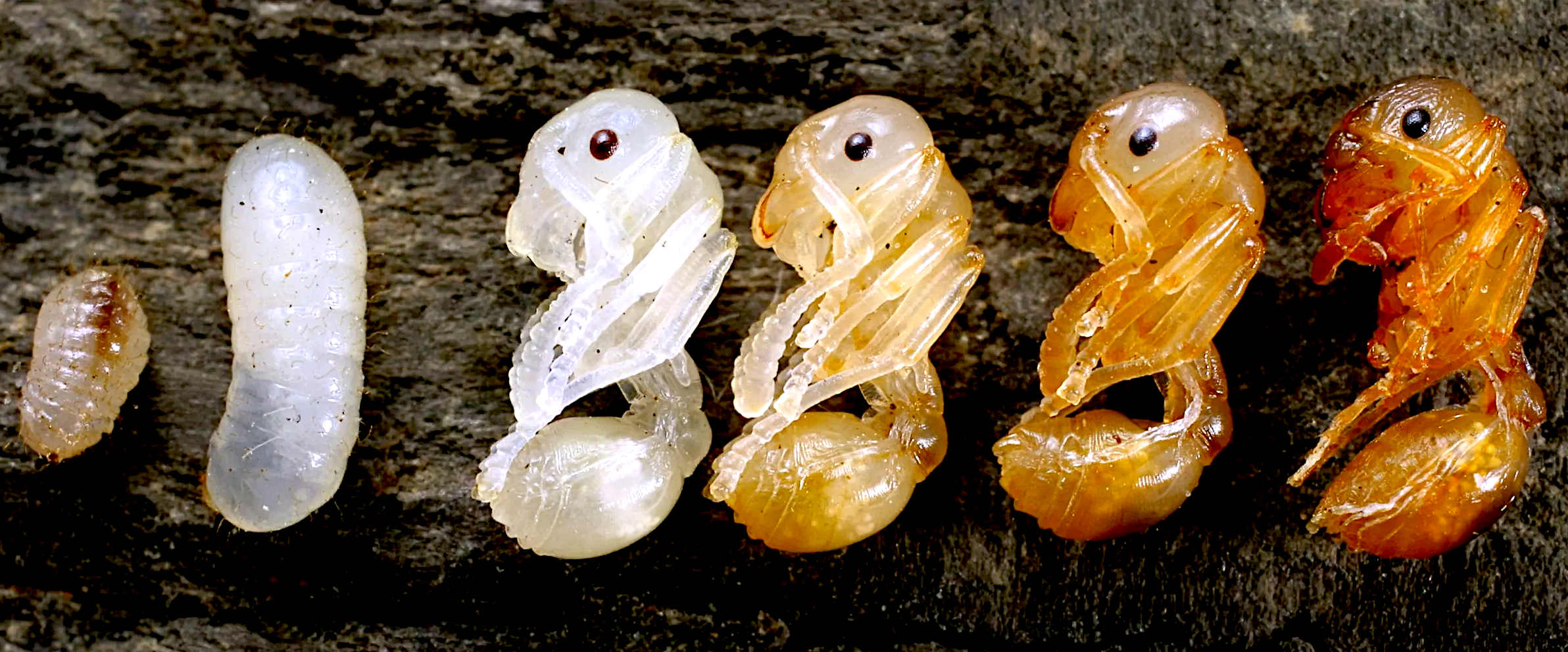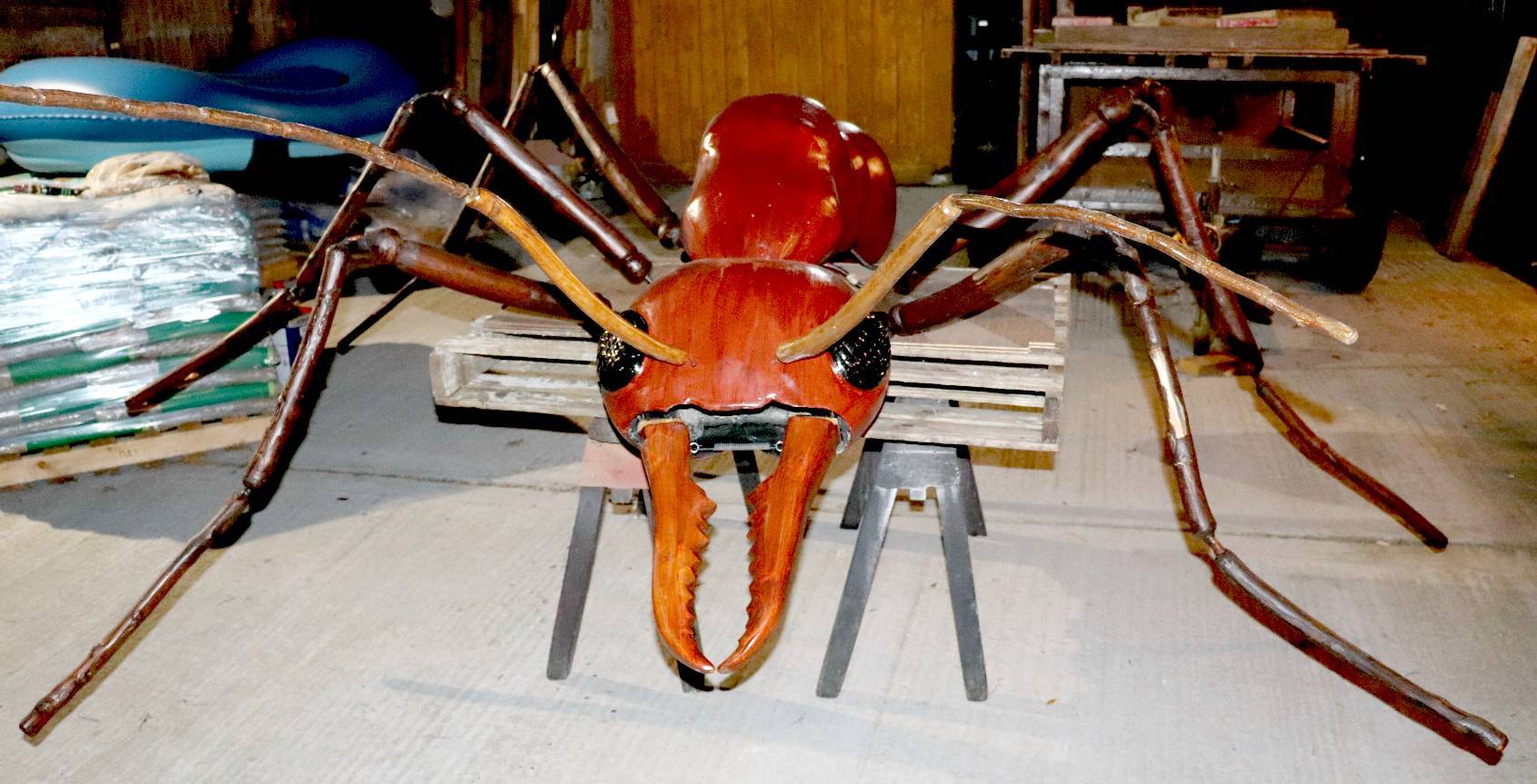
ARTWORK
- Somewhat better than the huge ants in "Them," but perhaps not as good as
the CGI in Antman. Now a
museum
exhibit in Sussex, England.
The artwork is based on the incredible Australian Bulldog
ant.
As
anyone who may have watched a colony at work, ants are some of the most interesting of insects.
They are incredible engineers, builders of pyramids
made of twigs and leaves, or underground labyrinths of tunnels in earth. They are amazing biological machines, that can lift
or support, between 20-100 times their own body weight. Thanks to an
exoskeleton, a tough polymerized shell of chitin; no skin. Rather than a
calcium bone based endoskelton, muscles and soft skin, as the outer
layer.
But
what of their life cycle. How is it that Lin
Po Chang can crate up and egg, and the larvae develop past pupae
stage, into a fully grown adult, while on a voyage from Antarctica
to England?
Typically,
the life cycle of an ant starts with a fertile queen digging into the ground to make a small cell
in which she lays eggs. These hatch in about 3-4 weeks into larvae. Within a further
5 weeks these larvae turn into adult ants. Compared to the gestation of
humans, the developmental process is rapid. About seven to ten weeks in
total.
At the start of this reproductive behavior, winged males and virgin winged queens swarm out from the existing nest in search of a partner from another colony.

Ant
eggs in a colony being tended by worker (females). They are all sisters;
clones.
When the adult hatches, it is fully grown and developed as its exoskeleton
hardens, and prevents it from growing larger.
ANT LARVAE
The next stage of the ant life cycle is the larval phase. Here, ant eggs hatch into worm-like larvae, which don't have eyes or legs. The ant larvae are fairly helpless and eat constantly, relying on workers to feed them. Throughout this stage of the ant life cycle — which only lasts six to 12 days — the larvae will molt several times as they grow larger.
This is also the stage at which future queens are determined: Ant larvae that are hatched from fertilized eggs and fed more develop into queens. These queens fly off to establish new colonies of their own.
ANT PUPAE
After molting several times, the ant larvae pupate. At this stage, the pupae start to resemble the ants you're familiar with. However, their antennae are folded tight against their bodies. Additionally, the pupae are paler in color, starting out almost white and darkening over time.
In some species of ant, the pupae spin cocoons for protection, while other species remain uncovered. Regardless of species, this phase of the life cycle is one of
last. During this time, which spans the course of nine to 30 days, the pupae metamorphosize into adult ants.

Sizes
of different species
ADULTHOOD
When an adult ant emerges, it's fully grown. Because ants have such hard exoskeletons, they're unable to grow any
larger, thus the food supply during those formative days is important.
More food yields a bigger animal, less, a smaller one.
When ants reach adulthood, they start to perform their roles in the colony. Each ant belongs to one of three major casts — queens, female workers or male drones — which, as you saw above, are all determined by factors that take place in the egg and larvae stage.
HOW LONG DO ANTS LIVE?
An ant's caste, or position within the colony will ultimately determine its lifespan. Males, for example, only live for a few weeks and die after mating with a queen.
Some garden black ants (lasius niger) can live for up to two years. In
other species the female workers can live for several months. Queen ants, on the other hand, can live for decades. In some species, the queens can live to be 30 years old.
STARTING NEW COLONIES
Once mated, the queen never mates again. Instead of repetitive mating, she stores the male’s sperm in a specialized pouch until such time as she opens the pouch and allows sperm to fertilize the eggs she produces.
After mating, queen ants and male ants lose their wings. The queen scurries off in search of a site to start her new nest. If she survives, she digs a nest, lays eggs, and single-handedly raises her first brood that consists entirely of workers. After mating, the male generally lives a short life in isolation.
The nest’s queen controls the gender and function of her offspring since her fertilized eggs become either wingless female workers or reproductively capable virgin queens.

An
illustration of the ant life cycle
Not every egg develops into an adult; nestmates eat some as extra food. An egg grows into a worm-shaped larva that has neither eyes nor legs beyond this stage.
When a larva is large enough, it later changes into a pupa. This is a time of reconstruction and rehabilitation. Pupae resemble adults more, despite having their legs and antennae folded inward against their bodies.
After laying eggs, ants develop into adult ants after 7 to 14 days. They begin to hatch, and as is natural, the head emerges first. As a result, the ant larvae resemble ant eggs nearly exactly, except that the eggs have small heads that constantly need food. The larvae can stick together during transportation because of their adhesiveness.
This is the time when the ants choose their life roles or obligations. So the ant life cycle larval stage appears to be the most crucial. An ant can develop into a queen, a male, or a worker, depending on how much food is provided.
WHAT DO THEY EAT?
They are primarily fed proteins by the worker ants, which are crucial for the process of body formation. Ant larvae can be observed moving around and changing positions to attract the attention of the worker ants, who very obediently feed them.
Normally, feeds are first digested by the workers, who then liquidize them and regurgitate them to the larvae. Liquids are simpler to digest than solid foods. Researchers have discovered that some ant species feed their larvae solid food that has been ground into tiny particles. Lin Po Change knows this and makes sure that he packs enough food and liquids for the egg, just in case development begins without him.
Although they can break down solid foods, larvae prefer liquid food. These ant feeds include the bodily fluids that ant workers have regurgitated, which meet all their nutritional requirements for survival and growth.
The ant larvae have hook-like shapes and are white with a hint of transparency. Similar to the sticky outer layer of ant eggs, they feature hairs that attach to their surfaces. Ant larvae resemble tiny maggots and are extremely similar to ant pupae in appearance. Both ant larvae and ant pupae are covered in a white, waxy layer that gives them the appearance of being white or yellowish. Ant larvae also lack the completely formed muscles and wings that they subsequently acquire as adults.
Larvae are known to go through stages of development known as molting, and during each step, the larvae shed their skin. The larvae may lose their skin a minimum of three times in total.
The vast majority of the thousands of species of ants have four separate stages in which their larvae develop. These phases see adjustments to the larvae’s external and internal structures. Ant larvae grow bigger and straighter with each stage, changing in size.
Ant Larvae Appearance by Stages
The texture and appearance of the hairs on the body also differ. The larvae’s first stage has softer, shorter hair that seems to have some sheen to it. The hairs, however, gradually turn rough with hook-like points as the larvae progress to their fourth developmental stage.

The
developmental stages of an ant's life cycle, from an egg, to fully grown
worker
INSECT FEATURES
- The insect body is divided into three main parts, the head, thorax and abdomen.
- Insects have no internal skeleton, instead they are covered in an external shell (exoskeleton) that protects their soft internal organs.
- No insect has more than three pairs of legs, except for some immature forms such as caterpillars that have prolegs. These are appendages that serve the purpose of legs.
- The typical insect mouth has a pair of lower jaws (maxillae) and upper
jaws (mandibles) which are designed to bite. There are many variations to this structure, as many moths and butterflies have tubular sucking mouthparts, many bugs and other blood-sucking insects have sucking stabbing mouthparts and some adult insects
don't have functional mouthparts.
- Insects have one pair of antennae located on the head
- Most insects have one or two pairs of wings although some insects such as lice, fleas, bristletails and silverfish are completely wingless.

The
artwork is also suitable for use in "Jimmy Watson's Magic
Dinobot."
A proposed network TV serialization, about boy who saves his paper round
money to buy himself a robot for Christmas. Then, when assembled, it
come to life, to become his friend.





